1930s Cultural Influence
The Cultural Influence on 1930s Fashion in the 1930s
The 1930s marked a period of significant transformation in fashion, shaped by economic challenges and 1930s cultural influence and shifts. As society adapted to new realities, clothing evolved to reflect both practicality and a touch of elegance. This era saw the emergence of innovative designs and materials that redefined style for many.
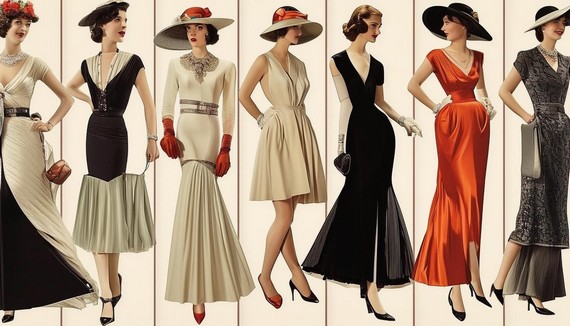
1930s fashion collage
Impact of the Great Depression on Fashion
The 1930s saw fashion lines adapting to the Great Depression. Skipping the lavishness of the roaring ’20s, the fashion world embraced practicality. People traded flamboyant flapper dresses for simpler styles, and a new chic emerged.
Clothes in this era were streamlined and functional. Designers showcased their creativity within limited resources. Women embraced garments that worked as hard as they did, with daywear featuring simple lines and modest flair. For evening affairs, bias-cut gowns hugged curves elegantly.
Men’s fashion evolved too, with suits featuring strong shoulders and tapered torsos. Casual wear made an appearance, briefly introducing the bold zoot suit before it was reserved for special occasions.
Fabric innovation played a key role. Rayon and nylon entered the scene, offering durability without breaking the bank. These materials helped create clothing that was both fashionable and functional.
Hollywood’s cultural influence in the 1930s was significant. Film stars like Greta Garbo and Marlene Dietrich set trends with their on-screen wardrobes, inspiring thrifty adaptations. The rise of ready-to-wear made stylish clothing more accessible to the average person.
Fashion magazines like Vogue and Harper’s Bazaar captured these stylish shifts, allowing everyone to glimpse the elegance emerging from hardship. In their pages, necessity mingled with glamour, proving that fashion, even in tough times, is about resilience and adaptability.
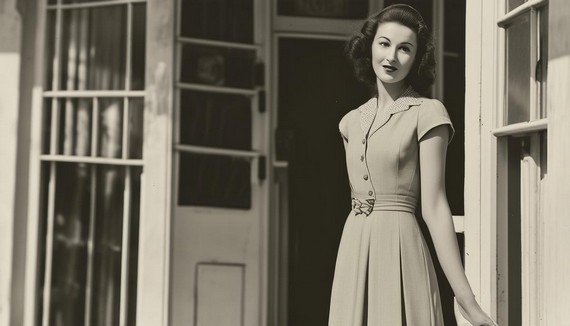
A woman wearing practical 1930s daywear, featuring a simple dress with modest flair and functional design
Hollywood’s Role in Fashion Trends
Hollywood had a significant impact on 1930s cultural Influences and fashion trends. As audiences were drawn to the silver screen, they also eagerly observed the sartorial choices of stars like Greta Garbo, Marlene Dietrich, and Joan Crawford. These actresses blended storytelling with style in a way that was both aspirational and relatable to viewers.
In a world dimmed by economic hardship, these glamorous stars offered a touch of escapism. Their on-screen costumes, often crafted by famed designers like Adrian, set fashion agendas and fueled desires for similar silhouettes. The bias-cut gowns pioneered by Vionnet swayed effortlessly on screen, inspiring viewers to seek similar styles.
Memorable moments in film in the 1930s had direct 1930s cultural Influence and impacts on fashion. Clark Gable’s bare chest in “It Happened One Night” reportedly caused a decline in undershirt sales. Adrian’s work on films like “The Wizard of Oz” and “Letty Lynton” captured imaginations and influenced hemlines across continents.
The influence of Hollywood was immediate and wide-ranging. Even if the glamorous gowns weren’t within reach for everyone, the film industry managed to democratize luxury by showcasing styles that became familiar and desired. People found ways to recreate these looks at home or sought out affordable replicas.
Cinema’s visual language gave people a shared reference point for fashion. The interplay of light and shade in black and white films heightened the allure of fabrics, creating a timeless appeal. With every film, Hollywood’s cultural influence on 1930s fashion grew, transforming the silver screen’s glamour into everyday style inspiration.
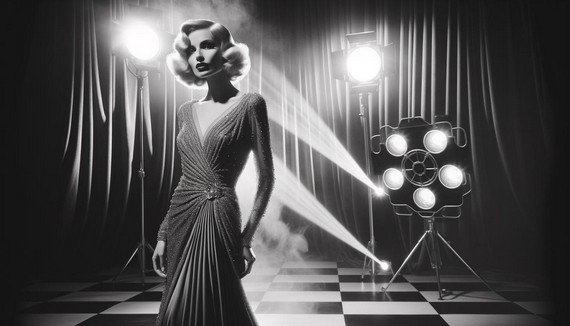
Marlene Dietrich in a glamorous 1930s film costume, showcasing Hollywood’s influence on fashion
1930s Cultural Influence – Key Fashion Trends and Innovations
The 1930s saw the emergence of several key fashion trends, cultural influences and innovations that defined the decade’s style. The bias-cut technique, pioneered by Madeleine Vionnet, revolutionized women’s fashion. This method allowed fabric to drape elegantly over the body, creating fluid silhouettes that were both comfortable and flattering. It transformed evening wear, offering a graceful alternative to the stiff corsetry of previous eras.
Backless dresses became a striking trend, adding a touch of daring to formal wear. While skirts modestly grazed the ankle, designers shifted focus to reveal bare skin along the back. This style choice balanced modesty with a hint of sensuality, making a bold statement in an era of economic conservatism.
The rise of sportswear reflected a growing cultural shift towards a more active lifestyle. Fashion houses introduced streamlined, relaxed garments that married function with form. Knit tops, wide-legged trousers, and comfortable blazers brought casual sophistication to everyday wear. This trend set the stage for future fashion developments and offered a fresh perspective on masculinity and femininity in clothing.
These innovations – bias cuts, backless designs, and the integration of sportswear – each left a lasting mark on fashion. They demonstrated that even during challenging times, style could evolve to offer new visions of elegance, audacity, and adaptability.
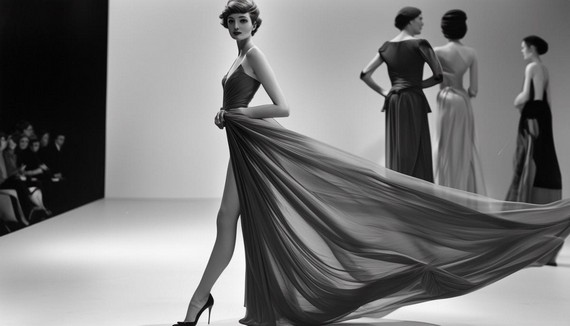
A model wearing a flowing bias-cut evening gown from the 1930s, showcasing the revolutionary draping technique
1930s Cultural Influence – Influential Designers of the 1930s
The 1930s cultural influences were shaped by several influential designers who left an indelible mark on fashion history. Madeleine Vionnet, master of the bias cut, created garments that celebrated the natural silhouette. Her designs draped women in gentle cascades of fabric, redefining elegance with an architectural approach that echoed the art deco movement’s emphasis on streamlined forms.
Elsa Schiaparelli brought surrealism to fashion, collaborating with artists like Salvador Dalí to create pieces that defied convention. Her use of trompe-l’oeil and bold elements like lobster prints on dresses pushed boundaries, bringing a playful yet sophisticated dynamic to 1930s cultural Influences and styles.
Coco Chanel, already celebrated for revolutionizing women’s fashion with the little black dress, continued to redefine femininity through clean lines and a minimalist approach. Her ability to fuse practicality with sophistication had profound effects and cultural influence in the 1930s and resonated deeply during an era where opulence was tempered by necessity. Chanel’s use of jersey fabric, once considered too humble for high fashion, symbolized a new era of comfort chic.
These designers offered women a vision that combined empowerment, elegance, and creativity. Their legacy of their impacts and cultural influence in 1930s fashion continues to inspire, showing that even in times of adversity, fashion can be a powerful form of expression and innovation.
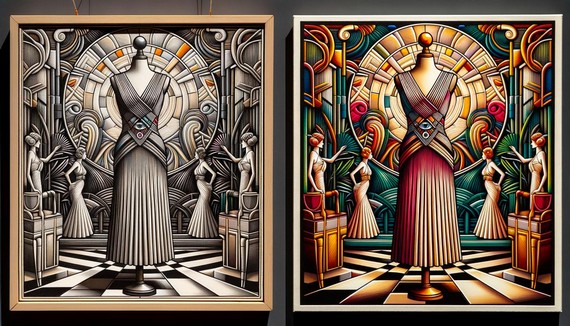
An Elsa Schiaparelli surrealist dress design from the 1930s, featuring bold and unconventional elements
1930s Cultural Influence – Evolution of Fabrics and Materials
The 1930s saw a significant evolution in fabrics and materials, largely driven by economic constraints that impacted the 1930s Cultural Influence in fashion . The introduction of synthetic fabrics like rayon and nylon marked a departure from traditional materials, offering new possibilities in garment construction.
Rayon, often called ‘artificial silk,’ emerged as a game-changer. It provided a luxurious look at a fraction of the cost of silk, making fashion more accessible. Its adaptability suited various garments, from evening gowns to day dresses, allowing more people to participate in the era’s style trends.
Another example of the evolution of fabrics and their 1930s cultural Influence is Nylon, introduced at the decade’s end, further revolutionized fashion accessibility. Initially celebrated for its use in stockings, its strength and elasticity quickly made it popular in various garments. The ability to mass-produce nylon items made previously luxury goods available on a broader scale.
These synthetic fabrics enabled designers to experiment with color and texture, creating bold yet durable pieces. They complemented the growing interest in ready-to-wear fashion and sportswear, facilitating the creation of lightweight, breathable garments suitable for modern life.
The incorporation of rayon and nylon represented a forward-thinking approach to fashion, balancing innovation with austerity. By making high fashion more accessible, these materials empowered 1930s Cultural Influence for individuals with greater choice in personal style. Even in times of economic difficulty, these new fabrics allowed for creativity and elegance in clothing design.
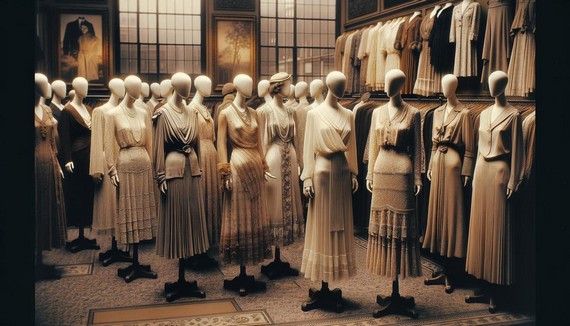
A display of 1930s garments made from rayon and nylon, showcasing the new synthetic fabrics of the era
Fashion and the creativity in 1930s cultural Influence demonstrated an incredible ability to adapt and flourish despite adversity. It was a time when creativity met necessity, resulting in styles that continue to influence our wardrobes today. The decade stands as a testament to the enduring spirit of fashion, where resilience and elegance walked hand in hand.
References:
- Vogue. The Figure Then the Frock. April 15, 1931.
- Vogue. The Utter Simplicity of the Vionnet Line. November 10, 1930.
- Vogue. What About Pants? Where? When? June 15, 1936.
- Hardin N. Does Hollywood Create? Vogue. February 1, 1933.
1930s Hollywood Impact in 1930s Culture
The evolution of animation and 1930s Hollywood cinema has been marked by impactful, pivotal moments that have shaped both industries. From the transformative leap of feature-length animation in the 1930s to the intertwining of fashion and film marketing in the 1960s, these developments have left a lasting impact on Hollywood storytelling and cultural trends.
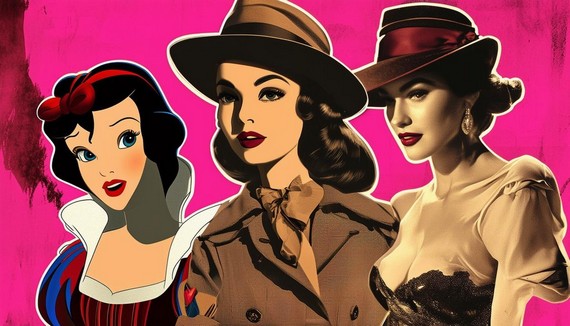
Cinema evolution collage
1930s cultural influence – Rise of Feature-Length Animation
1930s Hollywood saw a cinematic revolution with animation leaping onto the big screen. Walt Disney led this charge with his acclaimed feature film, Snow White and the Seven Dwarfs, released in 1937. This groundbreaking work reshaped the concept of storytelling on screen. Before Snow White, animations were mere snippets, short cartoon pieces shown before the feature film. But Disney’s venture offered a full-length adventurous odyssey.
Disney envisioned more than just laughs. He sought to weave a story rich in emotion and imagination, a tall order in an industry that had yet to fathom animation’s potential. Snow White was a resounding success, cementing Disney as both a visionary and an innovator. This wasn’t just a film; it was the dawn of a new era, where animation seeped into the consciousness of audiences worldwide.
The film’s impact and cultural influence was significant, altering the landscape of 1930s Hollywood. Other studios, suddenly aware of this new potential, scrambled to produce their own animations, but Disney was already ahead. While studios played catch-up, Disney was formulating plans for more captivating tales.
Beyond the box office, the 1030s cultural influence was undeniable. Snow White and her animated companions found their way into everyday life. Merchandise became popular, and children hummed tunes from the film. The prospect of animated films shifted from a whimsical venture to a legitimate and lucrative art form, paving the way for others like Pinocchio and Bambi.
In essence, the 1930s didn’t just birth feature-length animated films; it delivered creative exploration. Disney transformed the art of filmmaking, tested imaginations, and invited viewers into worlds where the ordinary became extraordinary.
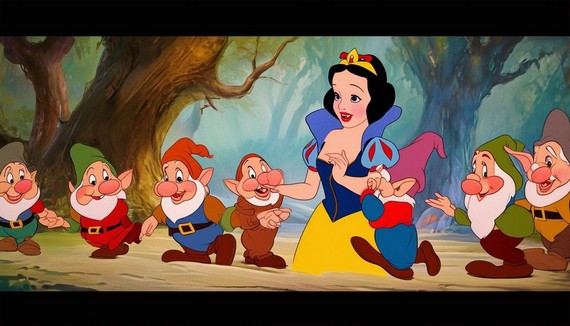
A colorful scene from Snow White and the Seven Dwarfs, showcasing the groundbreaking animation techniques of the 1930s
1930s Hollywood Fashion and Film Marketing
As we shift our focus to the 1960s, we find ourselves examining another Hollywood sensation that transformed both the silver screen and the fashion world. Bonnie and Clyde, directed by Arthur Penn and starring Warren Beatty and Faye Dunaway, redefined the framework of film marketing and its interplay with fashion, set in the 1930s the film became a cultural influence from the late 1960s.
Bonnie and Clyde was notable for its bold marketing strategy that blurred the lines between film and fashion. With minimal marketing budget provided by the studio, Warren Beatty’s innovative publicity efforts leveraged the film’s fashion as much as its thrilling storyline. Faye Dunaway’s portrayal of Bonnie became iconic, with costume designer Theadora Van Runkle adorning her in berets, pencil skirts and sweater sets—outfits evocative of the Dust Bowl yet appealing to contemporary audiences.
Through this fusion of cinematic art and fashion, the film’s garments transcended the screen, becoming a hallmark of style for the masses. Van Runkle’s creations weren’t just costumes; they represented the restless youth and rebellion against traditional styles. Dressed in earthy tones and vintage cuts, Dunaway not only sold an outlaw fantasy but became a style icon, influencing fashion towards the neo-Victorian hippie chic that would dominate the following decade.
The film’s real marketing triumph lay in its ability to infiltrate everyday wear, proving that cinema could influence fashion trends. This was no orchestrated advertising campaign; it was an organic eruption of fan enthusiasm, a testament to the power of on-screen style in shaping off-screen trends.
- Berets became a must-have accessory
- Calf-length skirts made a comeback
- Braless sweaters challenged contemporary norms
- Natural colors and textures gained popularity
From berets to trench coats, Bonnie and Clyde demonstrated the potential of cinema as a sartorial influence, its impact still resonating in fashion dialogues today. It emerged as a precursor to modern strategies where film and fashion interlace. It steered the conversation about how costume design could propel a story beyond the confines of the theatre, influencing how audiences dressed and even viewed themselves.
The legacy of Bonnie and Clyde in fashion is both a nod to the past and a glimpse into the future, reminding us that the art of film marketing extends far beyond the screen. It’s a tale of nostalgia, rebellion, and style—showing how a simple costume can unfurl into a cultural statement, altering the wardrobe of history.
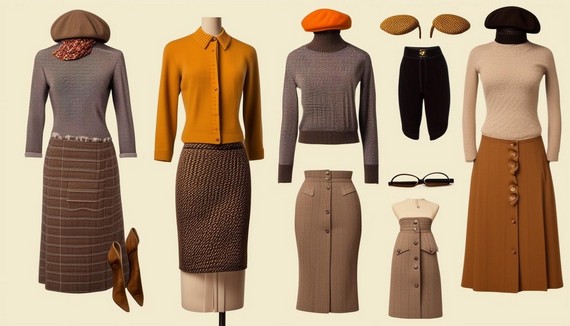
A collection of 1960s fashion items inspired by Bonnie and Clyde, including berets, pencil skirts, and sweater sets
1930s cultural influence – Studio Control Over Public Image
In 1930s Hollywood, studio heads exerted considerable control over their actors’ public images. The Hollywood moguls understood the power of a carefully curated public image—a combination of charisma, mystique, and fashion that could attract audiences while filling theatres.
Costume designers played a crucial role, crafting ensembles that became essential storytelling tools. These designers created striking silhouettes that moved seamlessly between screens and social events, blurring the lines between reality and cinematic illusion.
1930s Hollywood’s cultural influence extended beyond the silver screen to the very public appearances of its stars. Red carpets and opening nights were as orchestrated as the films themselves, with stars performing as themselves, albeit with studio-guided scripts. Costume designers ensured continuity, turning actresses into living models for the glamour seen on screen. Outfit choices were tactical decisions, signifying stories the studios wished to tell about their stars’ personas.
1930s Hollywood studios wrapped their stars in an almost mythical aura, crafting their public personas with precision. Clothing became a non-verbal pact with the public, with each carefully chosen ensemble maintaining a cherished image. The partnerships with designers were seamless, their creativity guided by studio directives.
Despite constraints, costume designers exercised remarkable cultural influence in the 1930s over fashion trends. The public, eager to emulate their beloved stars, turned to cinema-inspired styles, quickly adopting the latest onscreen aesthetics in their everyday lives.
However, this control was a double-edged sword. At times, it limited stars’ autonomy over their image, confining them to roles dictated by 1930s Hollwood studio executives rather than talent or ambition. Still, some stars like Joan Crawford mastered the art of self-promotion within the confines of studio strategy.
While the 1930s Hollywood era had its imperfections, lessons from this time echo through contemporary celebrity culture. Even today, the influence of such practices is evident in the celebrated ranks of stylists and their impact on image management.
In the end, studio control of public image was an endeavor to design dreams. As they carefully orchestrated both the extravagant and the everyday, 1930s Hollywood created a tableau where artists and audiences engaged in a delicate dance, unified in the allure of a well-spun story—bound by threads of dazzling fabric and the eternal charm of the silver screen.
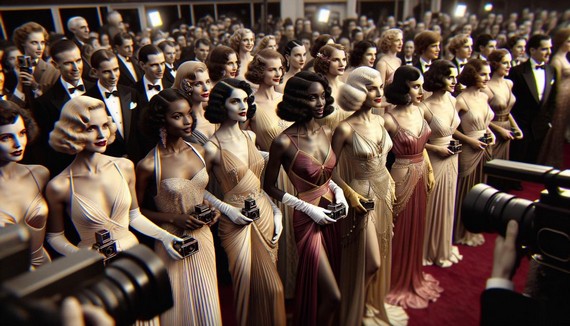
A glamorous scene depicting the controlled public image of 1930s Hollywood stars, with actresses in stunning gowns at a red carpet event
Ultimately, these 1930s Hollywood cinematic milestones highlight the enduring power of film to influence culture and fashion, creating stories that resonate beyond the screen. The legacy of these innovations continues to inspire and shape our understanding of storytelling and style.
References:
- Disney W. Snow White and the Seven Dwarfs. Walt Disney Productions; 1937.
- Penn A. Bonnie and Clyde. Warner Bros.-Seven Arts; 1967.
- Van Runkle T. Costume design for Bonnie and Clyde. Warner Bros.-Seven Arts; 1967.
- Time Magazine. Fashion: Bonnie’s New Look. Time. 1968.
- Life Magazine. Bonnie: Fashion’s New Darling. Life. 1968.
Golden Age of Hollywood
The 1930s were a time of striking contrasts in fashion, reflecting both the economic challenges of the era and the allure of the golden age of Hollywood. Practicality met glamour, as everyday attire balanced necessity with style, while the silver screen showcased more extravagant designs. This period marked a unique intersection where innovation and creativity flourished, offering a glimpse into how fashion adapted and thrived amidst adversity.
1930s cultural influence in Fashion
The 1930s saw a stark contrast between everyday practicality and the golden age of Hollywood’s glamorous fantasy. As the Great Depression tightened wallets, daywear focused on sensible choices. Women turned to jersey sportswear and matching skirt suits for a stylish yet economical look. Hemlines dropped, bringing modesty back into vogue, while waistlines returned to their natural position.
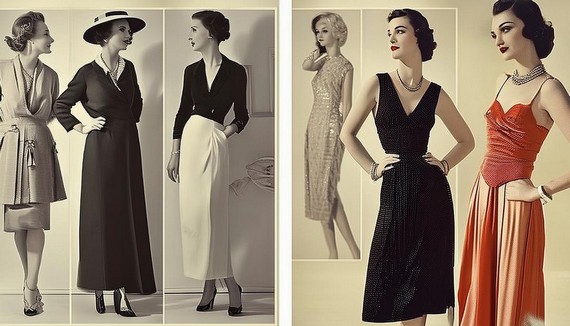
1930s fashion contrast
Evening wear, however, took cues from the golden age of Hollywood stars like Jean Harlow and Carole Lombard, who dazzled in floor-length gowns adorned with beads and sequins. The bias cut, popularized by Madeleine Vionnet, allowed fabric to drape flatteringly over the body. Plunging necklines and scooping backs added to the allure.
Essential Accessories:
- Hats: from doll hats to chic berets
- Gloves: varying in length for different occasions
- Hairstyles: often featuring finger curls or wave perms
While daytime meant practical fabrics, evening wear embraced luxurious textures like satin and silk. Colors remained vibrant, with daring purples and greens, warm rose hues, and vivid oranges. Sparkly brooches and elaborate necklaces could elevate even basic day dresses.
Women also adopted wide-leg flowing trousers, called ‘pyjamas’, for leisurely lounging or beach outings. Sports like tennis influenced the rise of sporty yet classy attire.
The era’s fashion reflected a balance between necessity and fantasy, showcasing the resilience and creativity of the time.
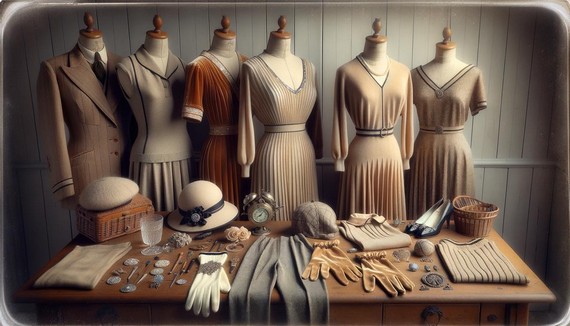
A collection of 1930s fashion essentials including a skirt suit, bias-cut evening gown, doll hat, long gloves, and a sparkly brooch
Iconic Golden Age of Hollywood Fashion Designers
Behind the scenes, Hollywood’s fashion designers were the true artists shaping the era’s style. Coco Chanel, who had already revolutionized fashion in the 1920s, continued to influence 1930s fashion by introducing fabrics like tweed and jersey to everyday wardrobes. Her designs blended practicality with elegance.
Elsa Schiaparelli brought a dash of surrealism to fashion. Collaborating with artists like Salvador Dali, she crafted garments with unexpected prints and unique fabric manipulations. Her knitwear with trompe-l’œil prints captured imaginations, making statements that transcended the runway.
In the golden age of Hollywood, costume designers like Gilbert Adrian defined silver screen glamour. Working with stars like Jean Harlow and Katharine Hepburn, Adrian pioneered the broad-shouldered look that became synonymous with 1930s elegance. His work demonstrated how costume design could influence mainstream fashion.
Edith Head excelled in creating memorable and iconic outfits. Her keen eye for detail and understanding of character development through clothing established her as a household name in Hollywood and beyond.
These designers, each with their unique flair, became architects of the era’s timeless glamour and 1930s cultural influencers . They explored the boundaries between fantasy and reality, setting trends that have impacted fashion well beyond the 1930s.
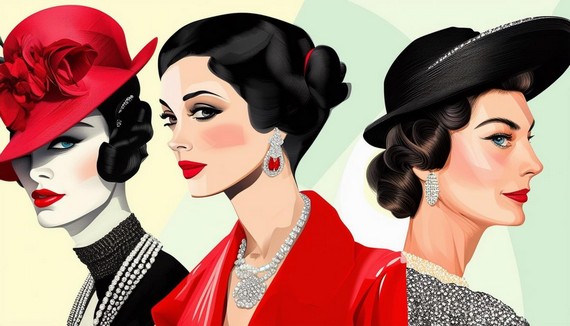
Portraits of iconic 1930s fashion designers Coco Chanel, Elsa Schiaparelli, Gilbert Adrian, and Edith Head
Golden Age of Hollywood Glamour Icons
Jean Harlow, the “Blonde Bombshell,” embodied 1930s glamour. Her platinum locks and figure-hugging gowns left a lasting impression on fashion. She favored bias-cut dresses that emphasized her curves, often in satin or sheer fabrics with plunging necklines and glistening details.
Carole Lombard was synonymous with chic sophistication. She balanced glamorous gowns with sleek menswear-inspired ensembles. Off-screen, her tailored skirt suits and graceful evening wear became emblematic of Hollywood elegance.
Joan Crawford’s fashion choices reverberated beyond her performances. She became a muse for designer Adrian, who famously amplified her shoulders with tailored suits that spoke of power and poise. These garments, often featuring broad shoulder pads, carved out new paths in women’s fashion.
“These golden age of Hollywood icons didn’t just wear clothes; they embodied them. Their individual styles became shorthand for power, confidence, and grace, influencing wardrobes beyond the studios of Hollywood.”
Women from all walks of life looked to Harlow’s glamour, Lombard’s sophistication, and Crawford’s powerful presence to guide their own style choices.
The impact of these starlets extended beyond fabric and sequins. They heralded a new age where glamour was a tool for empowerment, ambition, and self-expression. Their cultural influence in the 1930s continues to resonate in today’s fashion world.
Glamorous portraits of 1930s Hollywood icons Jean Harlow, Carole Lombard, and Joan Crawford in their signature styles
Technological Advancements and Fashion
Technological innovations amplified the golden age of Hollywood’s impact on fashion. The introduction of color film allowed the vivid hues and opulent textures of costumes to leap off the screen. This transition from black-and-white to color redefined how audiences perceived fashion, making lush purples, striking greens, and exotic pinks all the more influential.
Costume designers embraced this vibrancy, aware that each hue now had an emotional resonance. Films became visual spectacles, where every shade contributed to the allure. This encouraged viewers to adopt broader color spectrums into their own wardrobes.
Impact of Technological Advancements:
- Color film: Enhanced costume vibrancy and audience perception
- Intercontinental aviation: Facilitated global fashion exchange
- International press and fashion magazines: Documented celebrity style
- Air travel: Enabled collaboration between fashion capitals
The advent of intercontinental aviation shortened distances across the globe, carrying the golden age of Hollywood’s style beyond U.S. shores. This facilitated inspiration exchange between America and Europe and introduced Hollywood glamour to far-flung locales.
The rise of the international press and fashion magazines eagerly documented celebrities both on and off the screen. Paparazzi captured stars in their travels, inspiring the public with tales of exotic luxury lifestyles.
Air travel facilitated the flow of fashion ideas and trade, bringing forth collaborations between fashion houses in Paris, Milan, and New York. This diffusion of ideas forged a shared style narrative, where Hollywood’s cultural influence in the 1930s could inspire sartorial shifts within major fashion capitals.
These technological innovations reshaped perceptions of glamour. Color films invited audiences to experience fashion as part of a full-sensory tapestry, while air travel turned style into a mobile, global phenomenon. As the world grew smaller, the dream of capturing silver screen glamour became more accessible to people everywhere.
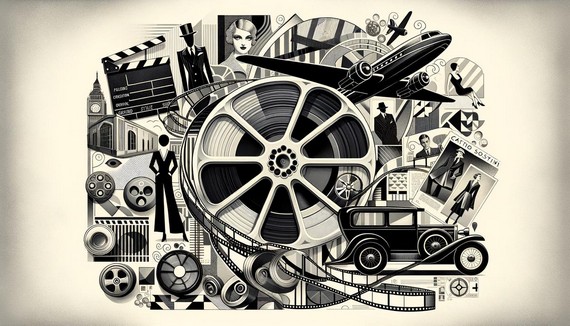
A montage showing the influence of 1930s technological advancements on fashion, featuring colour film, aviation, and fashion magazines
In reflecting on the golden age of Hollywood in the 1930s, it’s clear that fashion was more than just clothing; it was a statement of resilience and aspiration. The era’s blend of practicality and glamour left an enduring mark, illustrating how style can both ground us in reality and offer an escape into dreams. This legacy continues to inspire, reminding us of fashion’s power to transform and uplift.
References:
- Taschen. Life. Hollywood. New York: Taschen; 2023.
- Littlewood J. The History of British Fashion. London: Batsford; 2012.
- Mendes V, de la Haye A. Fashion Since 1900. London: Thames & Hudson; 2010.
1930s Social Changes
Fashion magazines have long served as both a reflection and catalyst of societal shifts, particularly during transformative periods. In the 1930s, these publications were instrumental in redefining 1930s Social Changes and women’s roles through style and self-expression. As the world moved through significant changes, fashion became a powerful tool for articulating new identities and aspirations.
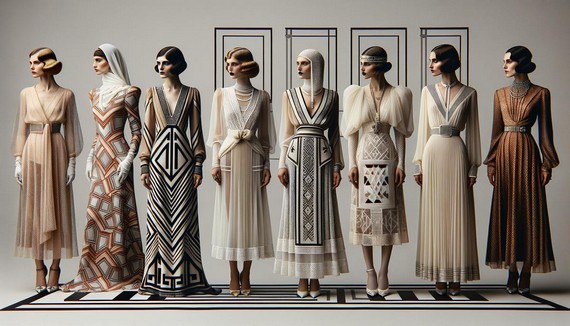
1930s fashion magazine spread
1930s cultural influence – Fashion Magazines and Modernity
Fashion magazines in the 1930s were more than just glossy publications; they were guides to modern living. Upmarket magazines like Vogue used photography and avant-garde art to capture the flowing lines of the female form, educating women on elegance and style.
Vogue’s 1935 issues showcased the geometry of body lines through clothes and photography, blending exercise and corsetry. Fashion columns catered to various tastes, from bold statements to subtle nods to modernity.
Women’s magazines acted as style tutors, offering beauty tips and introducing readers to new trends. They promoted novelty – new styles, shorter hemlines, and fresh haircuts – teaching readers how to be ‘modern’.
Some publications took a different approach. Feminist magazines often criticized mainstream fashion coverage, questioning how trends influenced female consumption patterns. Women’s Leader, for example, debated running its own dress feature to both acknowledge and challenge prevailing norms.
Magazines like Eve created characters to personify modern consumer society, giving readers relatable symbols to follow. Time and Tide used a playful format, featuring a faux ‘men’s page’ to poke fun at stereotypical women’s pages while still capitalizing on fashion advertising revenue.
For those seeking glamour, Girls’ Cinema delivered fashion as an exciting, aspirational experience, allowing readers to model their look after stylish film stars. By combining visual art with fashion, these magazines shaped a new sense of womanhood, offering women the chance to engage with and sometimes critique social norms.
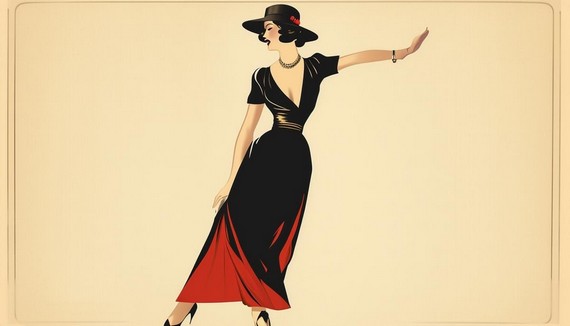
A stylish 1935 Vogue magazine cover showcasing a woman in elegant, modern 1930s fashion
1930s Social Changes Reflected in Fashion
The 1930s brought significant social changes, with fashion serving as both a mirror and a voice for these shifts. As women’s roles evolved, so did their clothing and self-expression. Skirts became shorter, haircuts bolder, and styles more androgynous, reflecting a growing desire for independence and empowerment.
With more women entering the workforce, practical yet fashionable attire became essential. Dresses and suits borrowed elements from menswear, signifying strength and capability. This fashion renaissance allowed women to project their evolving identities as pillars of society, workers, and fashion enthusiasts.
Cosmetics also played a role in this transformation, with bold lips and smoky eyes becoming popular. This new approach to beauty aligned with women’s desire to be seen and heard in a changing world.
The rise of consumer culture fueled this sartorial evolution, with magazines curating wardrobes and lifestyles that were both aspirational and attainable. Through fashion, women found a new language to articulate their shifting roles and aspirations.
As 1930s social change trends became more accessible across social classes, fashion became a universal dialogue. This period shaped how women perceived fashion and revolutionized their roles in society, providing them with the tools to carve out new identities.
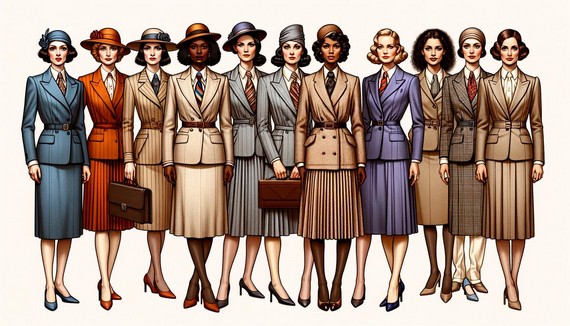
A group of diverse women in 1930s workplace attire, showcasing practical yet fashionable styles with menswear-inspired elements
1930s social changes – Feminism and Fashion
The 1930s saw a complex relationship between feminism and fashion. Feminist publications like Time and Tide criticized fashion’s influence on women’s lives while still featuring advertisements from department stores, recognizing 1930s fashion’s undeniable appeal and financial importance.
Feminist magazines were skeptical of the commercialized fashion world, seeing it as promoting unattainable ideals of beauty and consumption. They often linked these critiques to broader discussions about capitalism and its impact on women.
However, these publications also acknowledged fashion’s potential for self-expression and identity formation. They recognized that fashion could disrupt and redefine gender norms, supporting women’s emancipation.
Women adopted styles that borrowed from menswear, such as jackets and trousers, creating a more androgynous look that was both modern and subversive. This shift reflected women taking control of their sartorial choices and challenging traditional roles.
The feminist critique of fashion contributed to a wider cultural discussion on female autonomy. It raised questions about whether clothing choices were a path to liberation or another form of societal constraint.
Magazines like Time and Tide maintained a playful approach to fashion, using humor to subvert gender conventions while still engaging with fashion’s allure. This balanced approach allowed for broader conversations about 1930s cultural influences and women’s roles in society.
Ultimately, the relationship between fashion and feminism in the 1930s was dynamic, involving opposition, adaptation, and reinvention. It empowered female readers to question, embrace, and redefine fashion as both a personal choice and a reflection of broader societal changes.
1930s social change – Biba and Radical Social Changes
In the 1970s, Biba emerged as a symbol of rebellion in fashion, challenging traditional norms. Heavily influenced by 1930s fashion and decor, Co-founder Barbara Hulanicki created boutiques that welcomed society’s outsiders, offering a space where fashion could be a form of self-expression and reinvention.
The 1970s saw significant social upheaval, including advances in feminism, gay liberation, and civil rights. Biba’s inclusive ethos aligned well with these movements, celebrating diversity and self-expression without conforming to typical consumer ideals.
Biba’s embrace of androgyny resonated with the gay liberation movement. The boutique’s flamboyant displays and gender-neutral approach to clothing appealed to those challenging traditional gender roles. They even offered makeup for men, aligning with the glam rock trends of the era.
In support of civil rights, Biba launched a makeup range for black skin, recognizing the diversity of their clientele. This move was both a business decision and a statement about representation in the fashion industry.
Biba evolved with its customers, growing from the playful mini-skirt styles of the ’60s to a more sophisticated offering. Big Biba, its later iteration, expanded beyond fashion to include homeware and children’s wear, embodying a complete lifestyle.
- Biba made fashion accessible to all, combining affordability with avant-garde style.
- Through Biba, fashion became a means of expressing change and individuality.
- Its legacy lies not just in its designs, but in its role as a catalyst for social change, promoting inclusivity and self-expression through fashion.
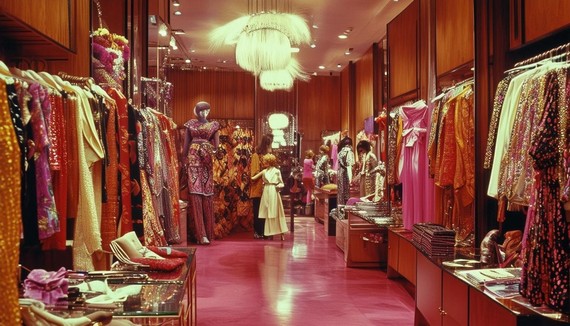
The interior of a Biba boutique in the 1970s, showcasing flamboyant displays and diverse clientele
Ultimately, 1930s social changes in fashion were more than a superficial trend; it was a profound expression of societal transformation. Through the pages of magazines, women found a voice and a means to challenge traditional norms, paving the way for future generations to embrace fashion as a form of empowerment and change.
References:
- Hulanicki B. From A to Biba: The Autobiography of Barbara Hulanicki. London: V&A Publishing; 2007.
- Beetham M. A Magazine of Her Own?: Domesticity and Desire in the Woman’s Magazine, 1800-1914. London: Routledge; 1996.
- White C. Women’s Magazines 1693-1968. London: Michael Joseph; 1970.
1930s Social Changes In Britain were a period marked by significant economic and social shifts. As the nation grappled with the effects of the Great Depression, everyday life was transformed. From fashion to technology, and from cultural trends to lifestyle changes, this era was defined by a blend of resilience and creativity. People found new ways to adapt, turning challenges into opportunities for innovation and expression.
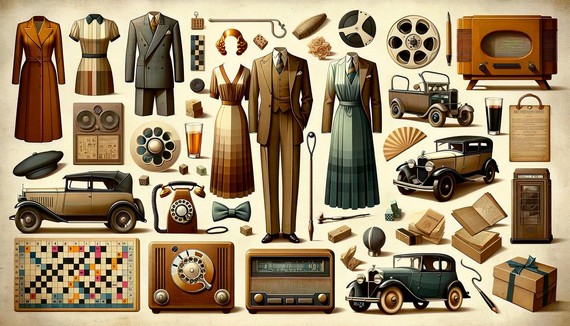
1930s british lifestyle collage
1930s social changes in Britain – Economic Shifts and Their Impact
1930s social changes in Britain began with the Great Depression, affecting how people shopped, lived, and worked. Families became more frugal, opting to repair rather than replace. Cars were maintained instead of upgraded, and clothes were patched or swapped.
Employment faced challenges, with the working class experiencing job cuts and reduced pay. Entertainment shifted to more affordable options like radio shows, DIY parties, and board games. Heating leftovers became a common practice.
1930s fashion adapted to economic realities. Hems lowered to conserve fabric, and simplicity became a new form of luxury. Unemployment rates were high in many cities, with some areas seeing nearly half the workforce without jobs. Charitable organizations worked hard despite their own struggles, highlighting the community spirit.
Children weren’t exempt from these changes. Child stars like Shirley Temple became fashion icons, inspiring creative solutions like using flour sacks for clothing. The era was characterized by resilience and determination to overcome hardships with both practicality and style.
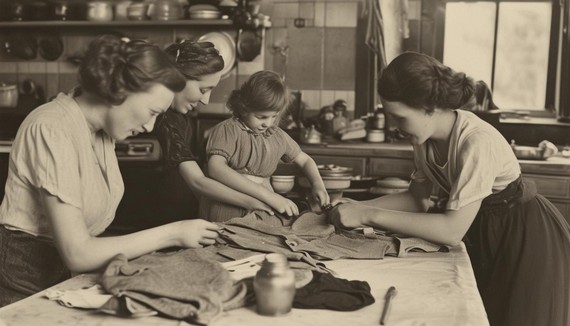
A 1930s British family engaged in frugal activities, repairing clothes and preparing simple meals
1930s social changes in Britain – Fashion Evolution and Social Influence
Fashion in the 1930s balanced resourcefulness and glamour. The era embraced softer, more feminine silhouettes with bias cuts becoming mainstream. Movie stars became style icons, with Hollywood a 1930s cultural influence influencing everyday fashion. Designers like Madeleine Vionnet and Elsa Schiaparelli brought new creativity to clothing.
Men’s fashion also evolved, inspired by silver-screen stars like Clark Gable. Casual elegance became popular, with changes in suit styles and accessories.
Technological advancements in fabrics, like rayon and nylon, provided affordable alternatives to luxury materials. The zipper gained popularity, offering a modern touch to clothing.
Fashion became more accessible to the general public. Economic challenges led to high-end copies and DIY efforts, bringing runway looks within reach of everyday people. Magazines offered patterns, allowing individuals to create their own versions of couture designs.
Despite the Great Depression and the profound 1930s social changes in Britain, fashion remained a source of hope and aspiration. It offered not just clothing, but a way to dream of better days ahead.
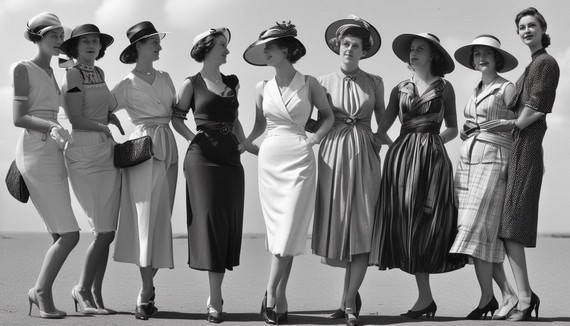
A group of British women showcasing 1930s fashion trends, including bias-cut dresses and Hollywood-inspired styles
Technological Advancements and Lifestyle Changes
1930s social changes in Britain saw significant technological progress that influenced daily life. Nylon and rayon became popular in clothing and other applications, offering affordable luxury. The concept of streamlined design emerged, affecting everything from radios to automobiles.
Transportation evolved with improved automobiles and the development of highways, making travel more accessible and enjoyable. These changes in transportation had a ripple effect on lifestyles and the social interactions of 1930s social changes in Britain.
Technological advances were 1930s cultural influences and reshaped daily routines. Innovations like the zipper saved time, while radios became central to family life. These advancements offered moments of optimism during challenging economic times, hinting at the potential for better days ahead.
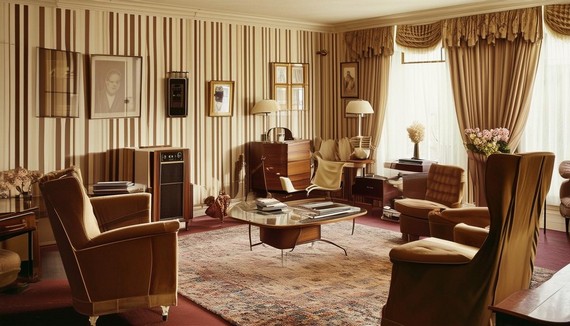
A 1930s British living room featuring new technologies like a streamlined radio and nylon stockings
1930s social changes in Britain – Cultural and Social Trends
The 1930s cultural scene provided an escape from the realities of the Great Depression. Cinema emerged as a popular form of entertainment, with Hollywood stars and varied genres offering fantastical worlds to audiences. Films not only entertained but also influenced 1930s fashion and social norms.
Radio was a major 1930s cultural influence and became a central part of home life, offering a mix of entertainment and news. Shows like “The Goons” and “Round the Horne” brought humor into homes, while news broadcasts kept families informed.
Board games, such as Monopoly, became popular family social pastimes, offering a mix of entertainment and escapism. Books and libraries provided another avenue for mental escape, with various genres catering to different tastes.
These cultural outlets didn’t just entertain; they also shaped 1930s social changes in Britain’s perspectives and norms. While economic challenges persisted, the arts and entertainment of the era helped maintain a sense of hope and community spirit.
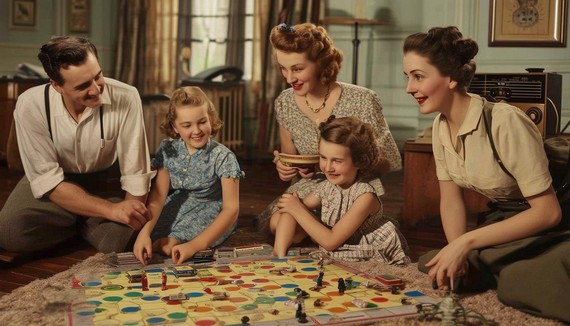
A British family enjoying various forms of 1930s entertainment, including cinema, radio, and board games
Amidst the challenges of the 1930s social changes in Britain, the enduring spirit of resilience shone brightly. Through creativity and adaptability, people found ways to thrive, demonstrating that even in difficult times, hope and ingenuity can lead to brighter days.
References:
- Blackman C. 100 Years of Fashion. London: Laurence King Publishing; 2012.
- Laver J. Costume and Fashion: A Concise History. London: Thames & Hudson; 1995.
- McDowell C. The Man of Fashion: Peacock Males and Perfect Gentlemen. London: Thames & Hudson; 1997
1930s Fashion in Art
Fashion and art have long been intertwined, with the 1930s marking a significant period of transformation. 1930s fashion in art saw designers like Madeleine Vionnas redefine how women dressed, turning clothing into an expression of elegance and freedom. The decade was a time of innovation, where garments became a canvas for creativity and societal change.
1930s Fashion in Art – The Influence of Madeleine Vionnet
Madeleine Vionnet revolutionized women’s fashion in the 1930s with her innovative bias-cut gowns. These dresses clung to the body’s silhouette, allowing for greater freedom of movement and elegance. Vionnet’s designs transformed how women’s bodies were presented, moving away from rigid structures to more fluid, graceful forms.
Her method of draping gowns on mannequins wearing only a maillot underneath was considered revolutionary at the time. This technique brought a sense of ancient Greek aesthetics into modern wardrobes. Other fashion houses, including Chanel and Schiaparelli, soon adopted the bias-cut method, marking a significant shift in clothing design.
“It is of the type first shown by Vionnet on mannequins wearing only a maillot beneath – an effect that is difficult to photograph successfully but that has aroused great interest throughout the fashionable world. Not static like the classic robes of the caryatids, these gowns have rhythm and movement and make the wearer look like a modern Diana or a winged Mercury.”
The backless dress also gained popularity during this period, shifting focus to the woman’s back rather than her legs. This style added an element of mystery and sophistication to evening wear. Simultaneously, trousers began to appear in women’s wardrobes, particularly for sports and leisure activities. Designers like Maggy Rouff and Elsa Schiaparelli created stylish outdoor trousers that combined artful 1930s fashion with functionality.
Cinema also played a crucial role and was a 1930s cultural influence in fashion during this era. Gilbert Adrian of MGM Studios became influential in Hollywood’s glamorous attire, with films serving as fashion showcases for the public. This led to discussions about whether Hollywood was creating new fashion trends or simply echoing Parisian styles.
Vionnet’s influence continues to inspire fashion designers and enthusiasts today, demonstrating how her artistic approach to clothing design in the 1930s has left a lasting impact on the industry.
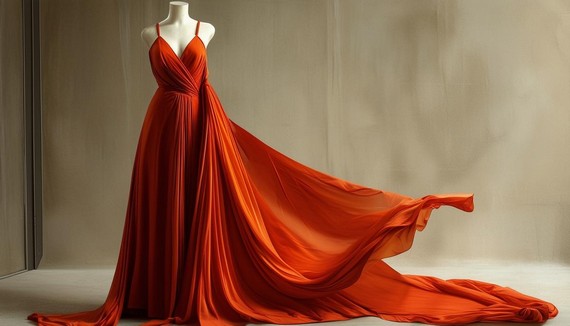
A Madeleine Vionnet bias-cut gown from the 1930s, draped elegantly on a mannequin, showcasing its fluid lines and Grecian-inspired aesthetic
1930s fashion in art – Backless Silhouettes and Undergarments
The rise of backless silhouettes in the 1930s marked a significant shift in evening wear, balancing elegance with a touch of daring. These designs allowed women to make a memorable impression, with the exposed back becoming a subtle yet impactful feature of formal attire.
This trend necessitated innovations in undergarments. Manufacturers developed new supportive pieces that wouldn’t show beneath the revealing backlines. These included:
- Delicate straps
- Soft bands
- Minimalist essentials
The creation of these new undergarments was as much about engineering as it was about style. Designers focused on the principle of “less is more,” crafting pieces that offered functionality without visibility. This approach influenced 1930s fashion in art, high-end couture and everyday women’s fashion, reflecting a broader societal shift towards more liberated styles that were a hallmark of 1930s cultural influence .
The backless trend represented more than just a change in fashion in the 1930s; it symbolized a form of artistic expression and personal freedom. Women wearing these gowns weren’t just participating in social events; they were part of a moving art gallery, embodying the spirit of an era that celebrated the harmony between fabric and form.
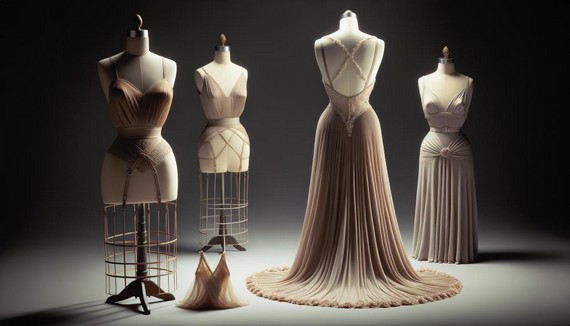
A 1930s backless evening gown displayed alongside innovative undergarments designed to be worn invisibly beneath, showcasing the engineering behind the glamorous style
1930s Fashion in Art – The Rise of Trousers for Women
The 1930s saw trousers making their way into women’s wardrobes, signifying a significant shift in fashion, 1930s cultural influence and societal norms. This trend reflected a broader cultural move towards practicality and modernity, especially during a time of economic challenges and global tensions.
Designers like Elsa Schiaparelli played a crucial role in popularizing women’s trousers, blending style with functionality. Wide-leg trousers became associated with leisure and empowerment, suitable for various activities from beach strolls to mountain excursions.
While the trend faced some initial resistance, it gained momentum partly due to the visibility of fashionable women wearing trousers in magazines like Vogue. These images showcased women engaging in sports and leisure activities, presenting trousers as both chic and practical.
“On they go – discussions about where and when women can wear slacks, shorts, culottes.”
Hollywood also contributed to the trend’s popularity, featuring heroines in trousers and adding glamour to the style. This helped to make trousers not just acceptable but desirable for women seeking independence and style.
The rise of trousers for women was more than a fashion statement; it represented a shift towards greater freedom and equality. It paved the way for future generations to enjoy a blend of style and comfort in their clothing choices.
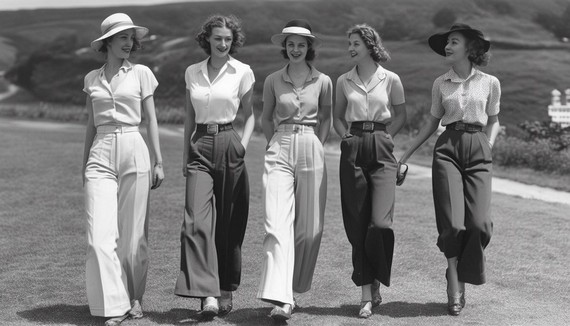
A group of fashionable women in the 1930s wearing wide-leg trousers for leisure activities, showcasing the blend of style and practicality
1930s cultural influence – Hollywood’s Role in 1930s Fashion in Art
In the 1930s, Hollywood emerged as a significant 1930s cultural influence in the fashion world. Costume designers like Gilbert Adrian at MGM studios became 1930s fashion icons, their artful influence extending beyond the movie sets. During a time of economic uncertainty, audiences found escapism in the glamorous wardrobes displayed on screen.
Adrian’s talent lay in creating costumes that not only complemented film narratives but also resonated with contemporary 1930s fashion. Actresses like Greta Garbo and Joan Crawford became style icons, their on-screen looks quickly adopted by the public.
The film industry began to shape its own fashion trends, which were then featured in magazines like Vogue. This led to a dialogue between Hollywood glamour and everyday streetwear, with audiences seeking to incorporate elements of cinematic style into their wardrobes.
“Only yesterday – Hollywood was a law unto itself. Its fashions were born and remained in Hollywood,” she writes before declaring: “Hollywood is originating fashion. The deity that rules over clothes knows that it was not always thus.”
Hollywood’s 1930s cultural influence on fashion in art wasn’t just about replication; it involved innovation. Adrian and other designers took risks, creating clothes that were both intricate and approachable. This approach made high fashion seem more attainable to the average person.
The fusion of cinema and style became emblematic of an era where fashion adopted a distinctly American flair. Hollywood’s impact on fashion continues to resonate, having reshaped the sartorial vocabulary of the time and leaving a lasting legacy in the fashion world.
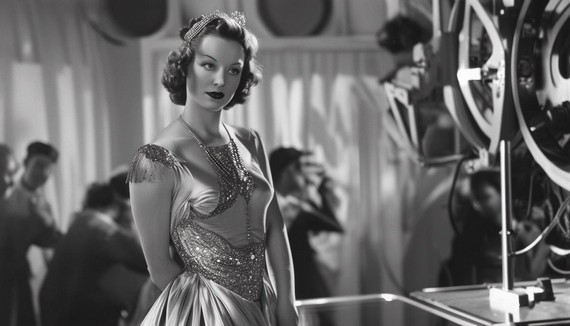
A glamorous 1930s Hollywood actress wearing an Adrian-designed costume on a film set, showcasing the influence of cinema on fashion
As we reflect on 1930s fashion in art in this transformative period, it’s clear that the fashion of the 1930s was more than just clothing; it was a statement of empowerment and artistry. The legacy of designers like Vionnet continues to inspire, reminding us that fashion is a powerful medium for expression and change.
References:
- Vogue. The Figure Then the Frock. 1931.
- Vogue. The Utter Simplicity of the Vionnet Line. 1930.
- Hardin N. Does Hollywood Create? Vogue. 1933.
- Vogue. What About Pants? Where? When? 1936.
1930s cultural influence – Surrealism in 1930s Art
Surrealism in 1930s art emerged as a significant artistic movement from the early 20th century, driven by a desire for greater freedom of expression. It evolved from literary roots into a visual phenomenon, reflecting the tumultuous socio-political landscape of its time. This artistic rebellion sought to challenge conventional norms and explore the depths of the subconscious mind.
Surrealism in 1930s Art – Origins and Evolution of Surrealism
Surrealism began in the early 20th century as artists and writers sought more freedom of expression. Initially more literary, with poets like André Breton exploring automatic writing, it soon expanded into visual arts. The movement was influenced by the devastation of World War I and Freud’s psychoanalysis, with Surrealists embracing the idea that dreams and the subconscious held keys to artistic expression.
Surrealism in 1930s art had blossomed into a visual feast and a major 1930s cultural influence . Artists such as Salvador Dalí, René Magritte, and Joan Miró became leading figures. Dalí’s work, with its twisted forms and melting clocks, invited viewers into a world where everyday logic took a backseat. Magritte juxtaposed ordinary objects in ways that challenged reality, while Miró blended colors and abstraction to capture dream-like qualities.
Surrealism in 1930s art’s influence extended beyond painting and sculpture, making its mark in literature, film, and early multimedia. Breton organized grand exhibitions, bringing together artists worldwide who were eager to tap into the unconscious mind. This era of Surrealism was as much about exploration as expression, redefining the boundaries of art and reality.
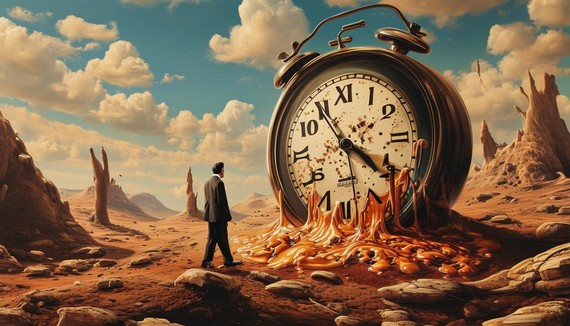
Salvador Dalí painting his famous melting clocks in a surreal landscape
Surrealism in 1930s Art – Key Figures and Their Contributions
Salvador Dalí, René Magritte, and Joan Miró were three pivotal figures who shaped Surrealism in 1930s art, each bringing a unique style and 1930s cultural influence to the movement.
- Salvador Dalí: Known for his eccentric persona, created dreamlike landscapes that challenged perceptions. His masterpiece, “The Persistence of Memory,” with its melting clocks, exemplifies his ability to blend reality with fantasy.
- René Magritte: His art was equally thought-provoking but more subtle in approach. His famous piece “The Treachery of Images,” depicting a pipe with the words “Ceci n’est pas une pipe,” encouraged viewers to question the nature of representation and reality.
- Joan Miró: Danced between abstraction and surrealism, using bright colors and simple forms to create playful, vibrant works. His “Dutch Interior” series showcases his ability to blend fantasy with reality, conveying the joy and mystery of the subjective mind through a unique visual language.
These artists embodied the spirit of Surrealism, each offering a distinct perspective on bridging the conscious world with the realms of dreams and the subconscious. The legacy of their 1930s cultural influence continues to inspire, demonstrating the power of art to redefine reality and explore the extraordinary within the ordinary.
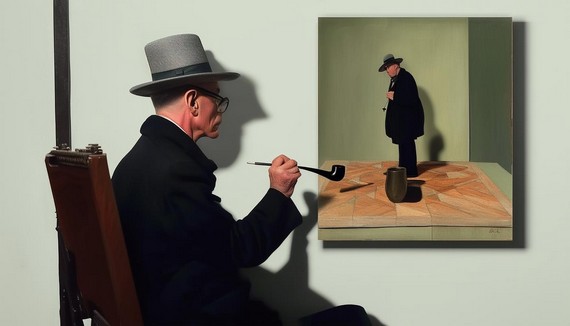
René Magritte working on his famous painting ‘The Treachery of Images’ featuring a pipe
1930s cultural influence – Techniques and Themes in Surrealist Art
Surrealist artists employed various techniques to tap into the subconscious and create unique works:
- Automatism: Allowed artists to create without conscious control, drawing directly from the psyche.
- Decalcomania: Used by artists like Max Ernst, involved pressing paint between surfaces to create unexpected patterns, embracing chance in the creative process.
- Grattage: Involved scraping paint off a canvas to reveal textures beneath, adding depth to artworks.
Central themes in Surrealist works included:
- Dreams: Artists attempted to capture the bizarre stories that unfold in our sleep.
- The unconscious mind: Served as a wellspring of inspiration, leading to compositions loaded with symbols and unexpected juxtapositions.
- Mythological imagery: Surrealists used ancient symbols and figures to explore deeper philosophical questions and bridge the gap between past and present.
These techniques and themes allowed Surrealists to delve into the mysteries of the mind, revealing the extraordinary within the ordinary. Each artwork became a step toward understanding the human psyche, blending chaos and order to create something truly unique.
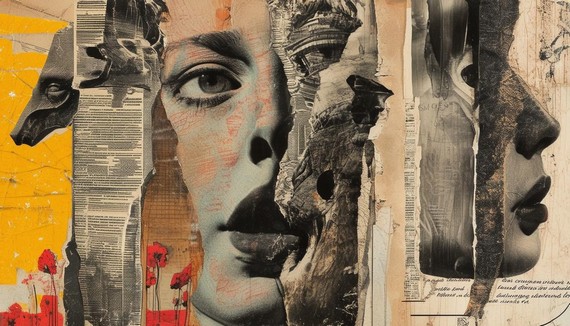
A collage of Surrealist art techniques including automatism, decalcomania, and grattage
1930s cultural influence – Surrealism and Political Context
The political landscape of the 1930s, marked by the Spanish Civil War and the rise of Fascism, heavily influenced Surrealism in 1930s art and was an important 1930s cultural influence for many artists. Many artists used their work as a platform for socio-political commentary, transforming canvases into battlefields of ideas.
Pablo Picasso’s “Guernica” (1937) stands as a powerful response to the bombing of the Basque town of Guernica. The monochrome mural, filled with distorted figures, conveys the chaos and suffering inflicted by war. Salvador Dalí’s “Soft Construction with Boiled Beans” (1936) depicts a self-mutilating creature symbolizing the internal strife of the Spanish Civil War.
Max Ernst’s “Europe After the Rain II” (1940-42) presents a post-apocalyptic vision of a continent ravaged by conflict, using his decalcomania technique to create a haunting landscape. These works reflect the artists’ attempts to grapple with the monstrous legacy of war and oppression.
Surrealism’s inherent opposition to rationalist thinking made it an ideal vehicle for challenging oppressive regimes. Filmmakers like Luis Buñuel used non-linear narratives and dreamlike imagery to subtly defy prescribed norms.
During this volatile period, Surrealism evolved into a profound expression of human resilience and became an important culural influence in the 1930s. Artists channeled their angst and hope into works that not only documented but also confronted the chaos of their time. This fusion of art and political consciousness underscores Surrealism’s capacity to be both an aesthetic revolution and a call against oppression.
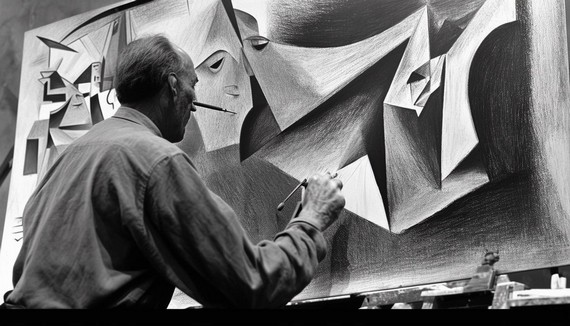
Pablo Picasso working on his monumental anti-war painting ‘Guernica’
Surrealism in 1930s Art’s Expansion Beyond Europe
Surrealism, while European in its origins, spread across the Atlantic during the 1930s and found a new home in the United States. This migration was driven by European artists fleeing the rising tide of Fascism, bringing with them the aesthetics and ideologies of Surrealism that would have cultural influence in the 1930s and significantly impact the American art scene.
As Europe faced the threat of war, Surrealist artists like André Breton, Marcel Duchamp, and Max Ernst sought refuge in America. They established communities and workshops that became hubs of creativity and 1930s cultural influence. Peggy Guggenheim’s gallery, Art of This Century, became a notable epicenter, offering a platform for Surrealists to exhibit their works and interact with local American artists.
The legacy of these European artists influenced a new generation of American painters such as Jackson Pollock, Mark Rothko, and Arshile Gorky. They absorbed the Surrealist fascination with the subconscious and reimagined it through an American perspective. This influence can be seen in:
- The raw, expressive canvases of Pollock’s drip paintings
- Rothko’s color fields, which carry traces of Surrealism’s focus on emotion and spontaneity
Exhibitions played a crucial role in establishing Surrealism’s foothold in America. The MoMA’s 1936 exhibition “Fantastic Art, Dada, and Surrealism,” curated by Alfred H. Barr, provided American audiences a comprehensive view of Surrealism’s intellectual and aesthetic vibrancy.
Surrealism’s cultural influence in the 1930s wasn’t confined to American shores alone. Its ideas spread to regions like Mexico and South America. In Mexico, artists like Frida Kahlo and Diego Rivera, though not formally aligned with the movement, incorporated elements of the surreal into their work, blending local stories with the fantastical.
In its global expansion, Surrealism adapted to new contexts while retaining its ethos of defying convention and probing the depths of the mind. This worldwide propagation ensured that Surrealism’s imagery and philosophies continued to inspire creativity and challenge orthodoxies beyond its initial geographic boundaries.
The transfer of 1930s cultural influence from Europe to America and beyond was not merely an extension of the movement; it was a transformation that invigorated art, ensuring Surrealism in 1930s art remained vibrant and universally relevant. This cultural cross-pollination proved that art knew no borders and that imagination, once unleashed, could indeed reshape the world.
Surrealism’s enduring cultural influence in the 1930s lies in its ability to transcend boundaries, both geographical and conceptual. By challenging reality and embracing the extraordinary, it continues to inspire artists and audiences alike, reminding us of the limitless possibilities within the human imagination.
Related posts:


